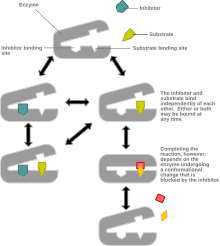Mixed inhibition


Mixed inhibition is a type of
Non-competitive inhibition is sometimes thought of as a special case of mixed inhibition.In mixed inhibition, the inhibitor binds to an allosteric site, i.e. a site different from the
substrate binds. However, not all inhibitors that bind at allosteric sites are mixed inhibitors. [1]
Mixed inhibition may result in either:
- A decrease in the apparent affinity of the enzyme for the substrate (Km value appears to increase; ) -- seen in cases where the inhibitor favours binding to the free enzyme. More closely mimics competitive binding.
- An increase in the apparent affinity of the enzyme for the substrate (Km value appears to decrease; ) -- seen in cases where the inhibitor favours binding to the enzyme-substrate complex. More closely mimics uncompetitive binding.
In either case the inhibition decreases the apparent maximum enzyme reaction rate ().[3]
Michaelis-Menten equation
to account for competitive and uncompetitive inhibition, respectively) are both greater than 1.
In the special case where α = α’,
noncompetitive inhibition
occurs, in which case is reduced but is unaffected. This is very unusual in practice.[3]
Biological examples
In
oxaloacetate into phosphoenolpyruvic acid, or PEP, when guanosine triphosphate, GTP, is present. This step is exclusive for gluconeogenesis, which occurs under fasting condition's due to the body's depletion of glucose. cPEPCK is known to be regulated by Genistein, an isoflavone that is naturally found in a number of plants. [4] It was first proven that genistein inhibits the activity of cPEPCK. In a study, the presence of this isoflavone resulted in a decrease in the level of blood sugar. A lowered blood sugar level means less glucose is in the blood. If this occurs in a subject that is fasting, this is because the gluconeogenesis was inhibited, preventing increased production of glucose. The ability of genistein to lower a person's blood sugar level allows it to be referred to as an anti-diabetic property. [4] The mechanism in which genistein inhibited the enzyme cPEPCK was further evaluated. First, cPEPCK was placed in the presence of 3-Mercaptopropionic acid, or 3-MPA, a known inhibitor of the enzyme. It was compared to the results of placing cPEPCK in the presence of genistein, which revealed that the mechanism of mixed inhibition was used to decrease cPEPCK's activity. [4] cPEPCK undergoes multiple configurations when catalyzing the formation of PEP. It can be either unbound, bound to GDP or bound to GTP. An experiment that studied the affinity for genistein in these different configurations was conducted. It revealed that geinstein favors binding to the cPEPCK with a bound GTP than then the enzyme with a bound GDP, which was found to be less stable.[4] This was because the GTP-bound cPEPCK revealed an extended binding site for genistein.[4] This is the same binding site as the enzyme's intended substrate, oxaloacetate while the other configurations did not do so in the presence of genistein. [4]
This provided evidence that the mechanism of inhibition of cPEPCK by genistein was a mixture of competitive and non-competitive inhibition.
A
Eadie-Hofstee diagram was plotted.[5] It confirmed that fukugetin acts as a mixed inhibitor by exhibiting varying but present affinities for the enzyme alone and the enzyme-substrate complex. Analyzing through kinetics, fukugetin decreased the Vmax while it increased the Km for these KLKs.[5] Typically, in competitive inhibition, Vmax remains the same while Km increases, and in non-competitive inhibition
, Vmax decreases while Km remains the same. The change in both of these variables is another finding consistent with the effects of a mixed inhibitor.
References
- ^ a b c "Types of Inhibition". National Institues of Health Chemical Genomics Center. 2011. Archived from the original on 8 September 2011. Retrieved 2 April 2012.
- ^ "Enzyme inhibition". London South Bank University. Archived from the original on 19 March 2012. Retrieved 2 April 2012.
- ^ ISBN 978-0-471-41090-4.
- ^ PMID 26528723.
- ^ PMID 26848109.





